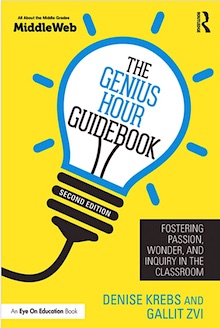Leading Genius Hour with 2 Middle Schoolers
Adolescents want independence, yet they still need a teacher who knows them and what they need to know.
I brought home the cash: nine crisp $50 bills. When I presented the $450 to the kids, my 8th grade son asked, “Can I make it rain?”
“Uh…sure. Just don’t lose any of them.”
A quick eye roll, then he preceded to deal out the bills into the air as my 6th daughter clapped and cheered. (I assume they learned about “making it rain” from the many hours on YouTube during the pandemic.)
Where the cash came from? One month prior, the kids and I had developed a plan for building a tree house in our backyard. They developed questions, found relevant information, designed possible plans, and created a digital presentation as their proposal. Part of the proposal addressed the costs associated with the tree house. Hence, we decided to put a curb on unnecessary expenses, such as carry out meals, for four weeks to save money and purchase supplies for the structure.
To support our collaborative inquiry, we referenced The Genius Hour Guidebook by Denise Krebs and Gallit Zvi. What did we learn, beyond the process for planning to build a tree house? I gained three insights from the experience.
Knowing kids well is the first priority
Prior to this project, my family and I had several conversations over the dinner table about the possibility of a tree house.
- “How big can the tree house be?” (Well, within reason…)
- “Can we have electricity?” (Only for a light; no wifi.)
- “Will there be a space for the cats?” (Do the cats really want to be up there with you?)
- “Would I be able to sleep in it?” (Naps, yes. Overnight, no.)
Our initial discussions fueled their motivations and helped us start to frame the work. Engaging in conversation and getting to know each other better is also effective for classrooms looking to eventually engage in self-directed inquiry. In our recent podcast conversation, Denise and Gallit note the importance of developing relationships prior to engaging in these experiences.
 “We don’t start a Genius Hour project with a new class until we’ve spent some time building community in the classroom. We generally spend the first few months working on building community…having classroom meetings, going outside and doing leadership challenges, playing games together, just spending that time, getting to know each other and building that trust before we say, ‘Hey, we want you to do something that can be a little bit risky, to take the chance and work on a project and share the obstacles you’re facing with the rest of the class.'”
“We don’t start a Genius Hour project with a new class until we’ve spent some time building community in the classroom. We generally spend the first few months working on building community…having classroom meetings, going outside and doing leadership challenges, playing games together, just spending that time, getting to know each other and building that trust before we say, ‘Hey, we want you to do something that can be a little bit risky, to take the chance and work on a project and share the obstacles you’re facing with the rest of the class.'”
Middle level learners need background knowledge
Adolescents sometimes act like adults, which can make educators forget (briefly) that they are still kids and have fewer experiences compared to us.
I realized this when my kids were tasked with creating questions about tree houses. All their wonderings fell at least partly in the “Google-able” category (as Denise and Gallit note, these are questions that can be answered with a Google search and not best suited for GH projects).
“We need more background knowledge,” I surmised. So we dug out books on backyard structures from my gardening library. The kids did some close reading, cut out favorite images, and eventually posted three smarter questions:
- What type of tree house would work best in our yard?
- What is the durability of the tree we have in mind?
- Is there enough trunk to build a tree house around?
Shared learning experiences make better demonstrations
The older students become, the less engaged they are in school. Some of this has to do with the amount of lecturing that still occurs at the secondary level. This teaching approach is easier for communicating information, especially when we are overloaded with too many preps and students. It’s not surprising that a teacher might fall back to this mode of instruction too often.
A more effective strategy is shared demonstration. Regie Routman describes this approach as the “we do it” part of instruction, in which the teacher “shapes the efforts, talking aloud about the ‘what’ and ‘why’ of the doing, and leading the way.”
For example, if we are showing writers how to construct a persuasive letter, we might develop a call to action around an important community topic for a local newspaper. The teacher is doing the typing, displayed on the screen, while the students are suggesting evidence to support their position.
In our situation, I led the way in developing our digital presentation. They stood by my side and offered their thinking while I typed and formatted the slides. Because we went through this process together, they were better able to present the slides in support of their tree house proposal to their authentic audience (my parents via Zoom).
The fruits of our labor currently sit in an envelope in our freezer (cold, hard cash!). As the snow melts here in Wisconsin, I have started asking my kids when we will begin making purchases for our tree house. Right now, I am either getting a noncommittal response (“I don’t know.”) or they did not hear me because they were watching YouTube.
Nevertheless, I am confident that the tree house will become a reality thanks to the time committed to creating a shared purpose, increasing our knowledge, and engaging in this process together.
Matt Renwick has served in public education for over 20 years. He started as a 5th and 6th-grade teacher in a country school outside of Wisconsin Rapids, WI. After seven years of teaching, he served as a dean of students at a junior high, which developed into an assistant principalship along with athletic director duties.
As an elementary principal for the Mineral Point (WI) Unified School District, he is enjoying the curriculum, instruction and assessment side of education. Matt is a 2021 recipient of the Kohl Foundation Leadership Award . He has published with ASCD and writes for Choice Literacy. He also publishes a popular newsletter for literacy leaders, Read by Example, and tweets @ReadByExample.


































